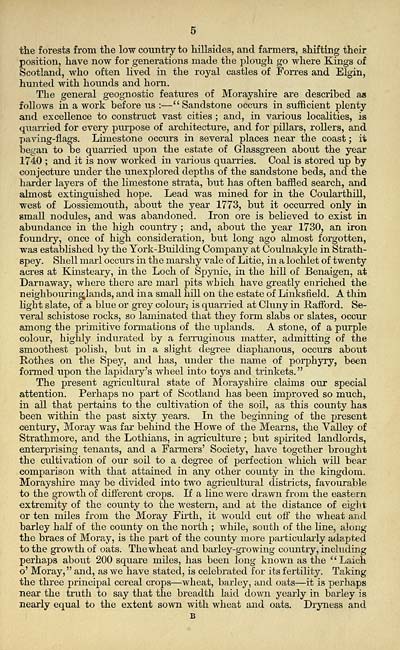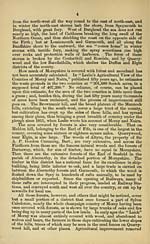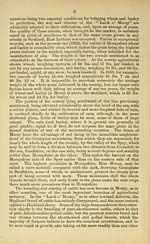Counties > Moray (Elgin) and Nairn Shires > 1863 - Black's Morayshire directory, including the upper district of Banffshire
(17)
Download files
Complete book:
Individual page:
Thumbnail gallery: Grid view | List view

the forests from the low country to hillsides, and farmers, shifting their
position, have now for generations made the plough go where Kings of
Scotland, who often lived in the royal castles of Forres and Elgin,
hunted with hounds and horn.
The general geognostic features of Morayshire are described as
follows in a work before us : — " Sandstone occurs in sufficient plenty
and excellence to construct vast cities ; and, in various localities, is
quarried for every purpose of architecture, and for pillars, rollers, and
paving-flags. Limestone occurs in several places near the coast ; it
began to be quarried upon the estate of Glassgreen about the year
1740 ; and it is now worked in various quarries. Coal is stored up by
conjecture under the unexplored depths of the sandstone beds, and the
harder layers of the limestone strata, but has often baffled search, and
almost extinguished hope. Lead was mined for in the Coularthill,
west of Lossiemouth, about the year 1773, but it occurred only in
small nodules, and was abandoned. Iron ore is believed to exist in
abundance in the high country ; and, about the year 1730, an iron
foundry, once of high consideration, but long ago almost forgotten,
was established by the York-Building Company at Coulnakyle in Strath-
spey. Shell marl occurs in the marshy vale of Litie, in a lochlet of twenty
acres at Kinsteary, in the Loch of Spynie, in the hill of Benaigen, at
Darnaway, where there are marl pits which have greatly enriched the
neighbouring^lands, and in a small hill on the estate of Linksfield. A thin
light slate, of a blue or grey colour,- is quarried at Cluny in Rafford. Se-
veral schistose rocks, so laminated that they form slabs or slates, occur
among the primitive formations of the uplands. A stone, of a purple
colour, highly indurated by a ferruginous matter, admitting of the
smoothest polish, but in a slight degree diaphanous, occurs about
Rothes on the Spey, and has, under the name of porphyry, been
formed upon the lapidary's wheel into toys and trinkets."
The present agricultural state of Morayshire claims our special
attention. Perhaps no part of Scotland has been improved so much,
in all that pertains to the cultivation of the soil, as this county has
been within the past sixty years. In the beginning of the present
century, Moray was far behind the Howe of the Mearns, the Valley of
Strathmore, and the Lothians, in agriculture ; but spirited landlords,
enterprising tenants, and a Farmers' Society, have together brought
the cultivation of our soil to a degree of perfection which will bear
comparison with that attained in any other county in the kingdom.
Morayshire may be divided into two agricultural districts, favourable
to the growth of different crops. If a line were drawn from the eastern
extremity of the county to the western, and at the distance of eight
or ten miles from the Moray Firth, it would cut off the wheat and
barley half of the county on the north ; while, south of the line, along
the braes of Moray, is the part of the county more particularly adapted
to the growth of oats. The wheat and barley-growing country, including
perhaps about 200 square miles, has been long known as the "Laieh.
o' Moray," and, as we have stated, is celebrated for its fertility. Taking
the three principal cereal crops — wheat, barley, and oats — it is perhaps
near the truth to say that the breadth laid down yearly in barley is
nearly equal to the extent sown with wheat and oats. Dryness and
B
position, have now for generations made the plough go where Kings of
Scotland, who often lived in the royal castles of Forres and Elgin,
hunted with hounds and horn.
The general geognostic features of Morayshire are described as
follows in a work before us : — " Sandstone occurs in sufficient plenty
and excellence to construct vast cities ; and, in various localities, is
quarried for every purpose of architecture, and for pillars, rollers, and
paving-flags. Limestone occurs in several places near the coast ; it
began to be quarried upon the estate of Glassgreen about the year
1740 ; and it is now worked in various quarries. Coal is stored up by
conjecture under the unexplored depths of the sandstone beds, and the
harder layers of the limestone strata, but has often baffled search, and
almost extinguished hope. Lead was mined for in the Coularthill,
west of Lossiemouth, about the year 1773, but it occurred only in
small nodules, and was abandoned. Iron ore is believed to exist in
abundance in the high country ; and, about the year 1730, an iron
foundry, once of high consideration, but long ago almost forgotten,
was established by the York-Building Company at Coulnakyle in Strath-
spey. Shell marl occurs in the marshy vale of Litie, in a lochlet of twenty
acres at Kinsteary, in the Loch of Spynie, in the hill of Benaigen, at
Darnaway, where there are marl pits which have greatly enriched the
neighbouring^lands, and in a small hill on the estate of Linksfield. A thin
light slate, of a blue or grey colour,- is quarried at Cluny in Rafford. Se-
veral schistose rocks, so laminated that they form slabs or slates, occur
among the primitive formations of the uplands. A stone, of a purple
colour, highly indurated by a ferruginous matter, admitting of the
smoothest polish, but in a slight degree diaphanous, occurs about
Rothes on the Spey, and has, under the name of porphyry, been
formed upon the lapidary's wheel into toys and trinkets."
The present agricultural state of Morayshire claims our special
attention. Perhaps no part of Scotland has been improved so much,
in all that pertains to the cultivation of the soil, as this county has
been within the past sixty years. In the beginning of the present
century, Moray was far behind the Howe of the Mearns, the Valley of
Strathmore, and the Lothians, in agriculture ; but spirited landlords,
enterprising tenants, and a Farmers' Society, have together brought
the cultivation of our soil to a degree of perfection which will bear
comparison with that attained in any other county in the kingdom.
Morayshire may be divided into two agricultural districts, favourable
to the growth of different crops. If a line were drawn from the eastern
extremity of the county to the western, and at the distance of eight
or ten miles from the Moray Firth, it would cut off the wheat and
barley half of the county on the north ; while, south of the line, along
the braes of Moray, is the part of the county more particularly adapted
to the growth of oats. The wheat and barley-growing country, including
perhaps about 200 square miles, has been long known as the "Laieh.
o' Moray," and, as we have stated, is celebrated for its fertility. Taking
the three principal cereal crops — wheat, barley, and oats — it is perhaps
near the truth to say that the breadth laid down yearly in barley is
nearly equal to the extent sown with wheat and oats. Dryness and
B
Set display mode to: Large image | Transcription
Images and transcriptions on this page, including medium image downloads, may be used under the Creative Commons Attribution 4.0 International Licence unless otherwise stated. ![]()
| Scottish Post Office Directories > Counties > Moray (Elgin) and Nairn Shires > Black's Morayshire directory, including the upper district of Banffshire > (17) |
|---|
| Permanent URL | https://digital.nls.uk/85597065 |
|---|
| Description | Directories of individual Scottish counties or parts of counties. |
|---|
| Description | Around 700 Scottish directories published annually by the Post Office or private publishers between 1773 and 1911. Most of Scotland covered, with a focus on Edinburgh, Glasgow, Dundee and Aberdeen. Most volumes include a general directory (A-Z by surname), street directory (A-Z by street) and trade directory (A-Z by trade). |
|---|


